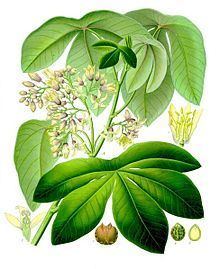Species M. carthaginensis | Subspecies M. c. subsp. glaziovii | |
 | ||
Similar Manihot, Maniltoa grandiflora, Pyrrosia nummularifolia, Euphorbia bracteata, Manihot grahamii | ||
The tree cassava or Ceara rubber tree, Manihot carthaginensis subsp. glaziovii, also known as Manihot glaziovii, is a species of deciduous flowering plant in the spurge family, Euphorbiaceae, that is native to eastern Brazil.
Contents
Description
Common Names
Uses
The tree cassava is used a source of rubber, instead of Hevea brasiliensis throughout the world. The plant is introduced largely in the world, but now it is classified as one of the highly invasive plant of the world.
Scientists found various enzymatic and inhibitory activities of tree cassava, which have insecticidal and anti-fungal proteins extracted from the latex of the plant. These proteins are effective against insects such as cowpea weevil, and fungi like Colletotrichum gloesporioides, Fusarium solani and Macrophomina phaseolina.
